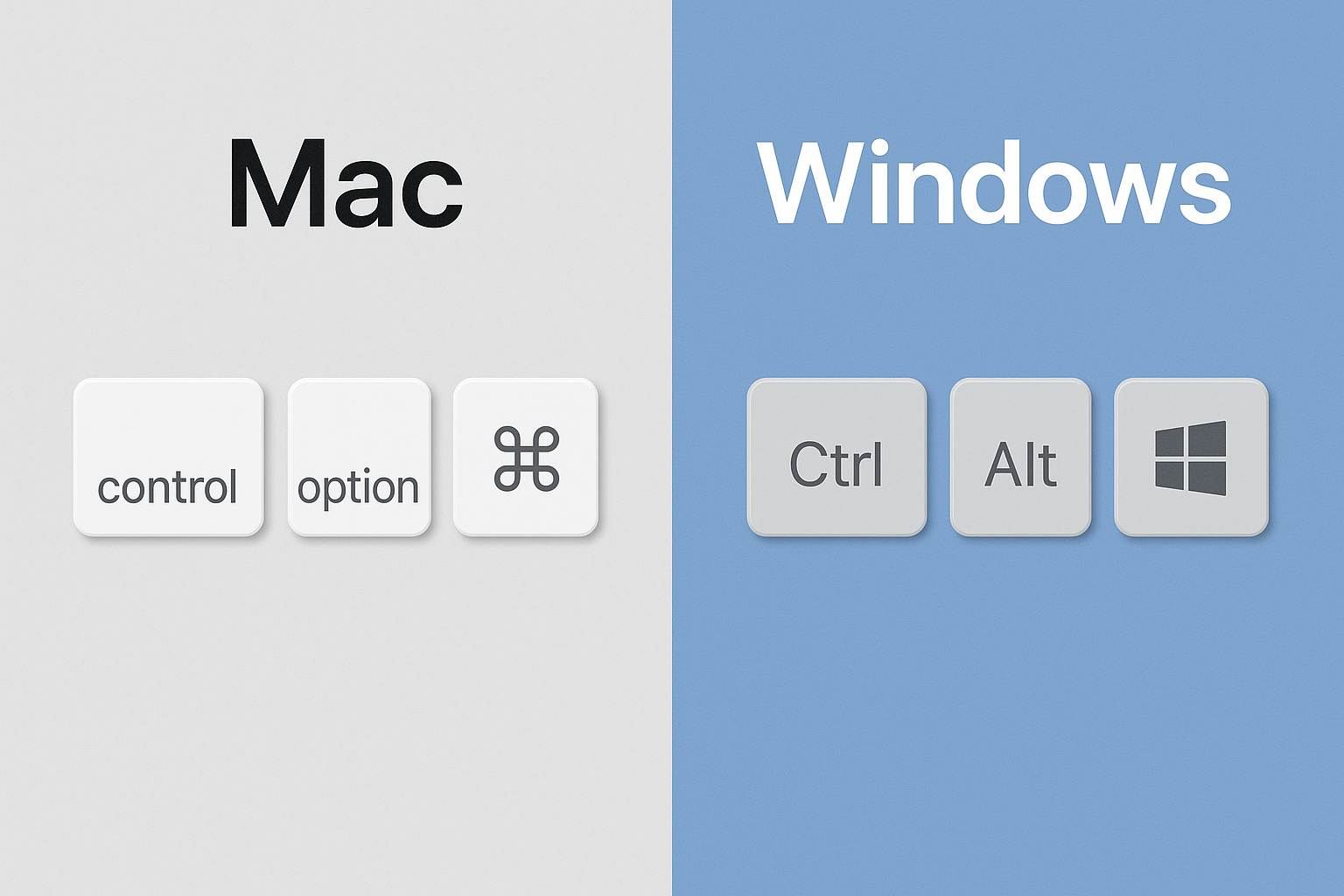Mac Keyboard Keys Explained for New Windows Users
If you’ve recently switched from Windows to Mac, you might be confused by the names and functions of certain keys—especially the three main ones: Control (⌃), Option (⌥), and Command (⌘). This article will walk you through what each key does and how they compare to Windows keys in a clear, simple way.
🔰 Understanding the 3 Main Mac Keys
If you’ve recently switched from Windows to Mac, you might be confused by the names and functions of certain keys—especially the three main ones: Control (⌃), Option (⌥), and Command (⌘). This article will walk you through what each key does and how they compare to Windows keys in a clear, simple way.
🔰 Understanding the 3 Main Mac Keys
Mac Key Main Function Windows Equivalent
⌘ Command | Used with other keys to perform actions (e.g., copy) | Ctrl
⌥ Option | Types special characters, adds alternate functions | Alt
⌃ Control | Used for right-click and Terminal shortcuts | Ctrl (specific use)
⌘ Command – The Star of macOS
⌘ Command | Used with other keys to perform actions (e.g., copy) | Ctrl
⌥ Option | Types special characters, adds alternate functions | Alt
⌃ Control | Used for right-click and Terminal shortcuts | Ctrl (specific use)
⌘ Command – The Star of macOS
The Command key is the primary shortcut key on Mac, replacing Ctrl on Windows.
Action Mac Shortcut Windows Shortcut
Copy | ⌘ + C | Ctrl + C
Paste | ⌘ + V | Ctrl + V
Undo | ⌘ + Z | Ctrl + Z
Open Spotlight | ⌘ + Space | N/A
Switch Apps | ⌘ + Tab | Alt + Tab
⌥ Option – The Secret Weapon for Power Users
Copy | ⌘ + C | Ctrl + C
Paste | ⌘ + V | Ctrl + V
Undo | ⌘ + Z | Ctrl + Z
Open Spotlight | ⌘ + Space | N/A
Switch Apps | ⌘ + Tab | Alt + Tab
⌥ Option – The Secret Weapon for Power Users
The Option key serves multiple roles, including typing symbols and modifying commands.
Usage Example
Type symbols | ⌥ + G = ©, ⌥ + 2 = ™
Delete entire word | ⌥ + Delete
Move cursor by word | ⌥ + → / ←
Reveal hidden menu options | ⌥ + click Wi-Fi icon
⌃ Control – For Specialized Use
Type symbols | ⌥ + G = ©, ⌥ + 2 = ™
Delete entire word | ⌥ + Delete
Move cursor by word | ⌥ + → / ←
Reveal hidden menu options | ⌥ + click Wi-Fi icon
⌃ Control – For Specialized Use
Control is not the main shortcut key like on Windows, but it's essential for specific actions:
Usage Example
Right-click | Control + Click
Terminal commands | Ctrl + C (stop), Ctrl + D (exit)
Lock screen | ⌃ + ⌘ + Q
🧩 Quick Comparison Table
Right-click | Control + Click
Terminal commands | Ctrl + C (stop), Ctrl + D (exit)
Lock screen | ⌃ + ⌘ + Q
🧩 Quick Comparison Table
Common Action Windows Shortcut Mac Shortcut
Copy | Ctrl + C | ⌘ + C
Paste | Ctrl + V | ⌘ + V
Undo | Ctrl + Z | ⌘ + Z
Switch Apps | Alt + Tab | ⌘ + Tab
Lock Screen | Win + L | ⌃ + ⌘ + Q
Right-click | Right-click | Control + Click
🎓 Summary for Beginners
Copy | Ctrl + C | ⌘ + C
Paste | Ctrl + V | ⌘ + V
Undo | Ctrl + Z | ⌘ + Z
Switch Apps | Alt + Tab | ⌘ + Tab
Lock Screen | Win + L | ⌃ + ⌘ + Q
Right-click | Right-click | Control + Click
🎓 Summary for Beginners
- Command (⌘) = Main shortcut key → Think of it as the new Ctrl
- Option (⌥) = Modifier key → Similar to Alt, but more versatile
- Control (⌃) = Special-use key for right-click and Terminal
If you’re new to macOS, just start by treating Command (⌘) as the new Ctrl, and you’ll adapt quickly. Understanding Option and Control will unlock more advanced capabilities over time.
Let me know if you’d like a visual keyboard guide or Mac shortcut cheat shee

